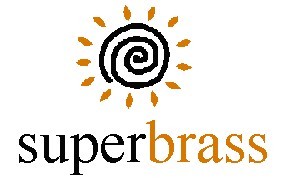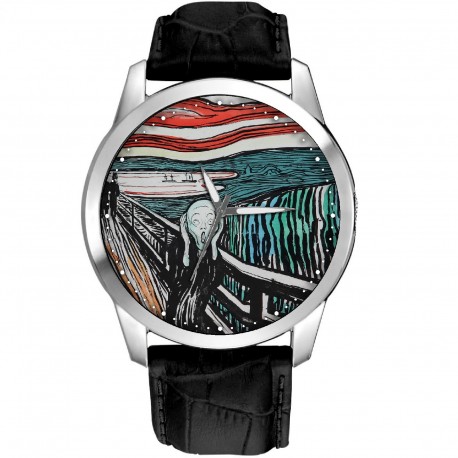No products
Renaissance & Art
New products
-

Seth vs Osiris, Ancient Egypt Metallic Original Art Solid Brass Collectible Mens' Watch
40 mm solid brass casing in gold finish with stainless steel back...
$ 121.44 -

Chinese Traditional Good Luck Dragon Art Gold Medallion Solid Brass Men's Watch
40 mm solid brass casing in gold finish with stainless steel back...
$ 129.59 -

English Colours Fire-Breathing Dragon Ancient Parchment Fantasy Art Brass Watch
40 mm solid brass casing in gold finish with stainless steel back...
$ 137.74 -

Ancient Blue Fire-Breathing Dragon Parchment Art Solid Brass Mens Dress Watch
40 mm solid brass casing in gold finish with stainless steel back...
$ 137.74 -

Golden Dragon Metallic Art Solid Brass Collectible Men's Fantasy Good Luck Watch
40 mm solid brass casing in gold finish with stainless steel back...
$ 121.44
Edvard Munch The Scream Vintage French Lithograph Print 40 mm Solid Brass Watch
New product
- impressive 40 mm solid brass casing with stainless steel back
- premium 2040 quartz movement.
- original parchment art acrylic dial
- waterproof bracelet with brass buckle
- 1 year warranty
More info
The Scream is the popular name given to a composition created by Norwegian Expressionist artist Edvard Munch in 1893. The original German title given by Munch to his work was Der Schrei der Natur (The Scream of Nature), and the Norwegian title is Skrik (Shriek). The agonised face in the painting has become one of the most iconic images of art, seen as symbolising the anxiety of the human condition.
Munch recalled that he had been out for a walk at sunset when suddenly the setting sunlight turned the clouds "a blood red". He sensed an "infinite scream passing through nature". Scholars have located the spot to a fjord overlooking Oslo[1], and have suggested other explanations for the unnaturally orange sky, ranging from the effects of a volcanic eruption to a psychological reaction by Munch to his sister’s commitment at a nearby lunatic asylum.
Munch created two versions in paint and two in pastels, as well as a lithograph stone from which several prints survive. Both of the painted versions have been stolen, but since recovered. One of the pastel versions commanded the fourth highest nominal price paid for an artwork at a public auction.
Sources of inspiration

In his diary in an entry headed "Nice 22 January 1892", Munch wrote:
One evening I was walking along a path, the city was on one side and the fjord below. I felt tired and ill. I stopped and looked out over the fjord—the sun was setting, and the clouds turning blood red. I sensed a scream passing through nature; it seemed to me that I heard the scream. I painted this picture, painted the clouds as actual blood. The color shrieked. This became The Scream.[2]
He later described his inspiration for the image:
I was walking along the road with two friends – the sun was setting – suddenly the sky turned blood red – I paused, feeling exhausted, and leaned on the fence – there was blood and tongues of fire above the blue-black fjord and the city – my friends walked on, and I stood there trembling with anxiety – and I sensed an infinite scream passing through nature.[2][3]
Among theories advanced to account for the reddish sky in the background is the artist's memory of the effects of the powerful volcanic eruption of Krakatoa, which deeply tinted sunset skies red in parts of the Western hemisphere for months during 1883 and 1884, about a decade before Munch painted The Scream.[4] This explanation has been disputed by scholars, who note that Munch was an expressive painter and was not primarily interested in literal renderings of what he had seen. Another explanation for the red skies is that they are due to the appearance of nacreous clouds which occur at the latitude of Norway and which look remarkably similar to the skies depicted in The Scream.[5][6] Alternatively, it has been suggested that the proximity of both a slaughterhouse and a lunatic asylum to the site depicted in the painting may have offered some inspiration.[7] The scene was identified as being the view from a road overlooking Oslo, by the Oslofjord and Hovedøya, from the hill of Ekeberg.[8] At the time of painting the work, Munch's manic depressive sister Laura Catherine was a patient at the mental asylum at the foot of Ekeberg.

In 1978, the Munch scholar Robert Rosenblum suggested that the strange, sexless creature in the foreground of the painting was inspired by a Peruvian mummy, which Munch could have seen at the 1889 Exposition Universelle in Paris. This mummy, which was buried in a fetal position with its hands alongside its face, also struck the imagination of Munch's friend Paul Gauguin: it stood as a model for figures in more than twenty of Gauguin's paintings, among those the central figure in his painting Human misery (Grape harvest at Arles) and for the old woman at the left in his painting Where Do We Come From? What Are We? Where Are We Going?.[9] In 2004, an Italian anthropologist speculated that Munch might have seen a mummy in Florence's Museum of Natural History, which bears an even more striking resemblance to the painting.[10] However, later studies have disputed the Italian theory, as Munch never visited Florence until after painting The Scream.[11]
The imagery of The Scream has been compared to that which an individual suffering from depersonalization disorder experiences, a feeling of distortion of the environment and one's self.[12]
Arthur Lubow has described The Scream as "an icon of modern art, a Mona Lisa for our time."[13] It has been widely interpreted as representing the universal anxiety of modern humanity.[14]
Versions
Munch created four versions, two in paint and two in pastels. The first painted version was the first exhibited, debuting in 1893. It is in the collection of the National Gallery of Norway in Oslo. A pastel version from that year, which may have been a preliminary study, is in the collection of the Munch Museum, also in Oslo. The second pastel version, from 1895, was sold for $119,922,600 at Sotheby's Impressionist and Modern Art auction on 2 May 2012 to financier Leon Black.[15][16] The second painted version dates from 1910, during a period when Munch revisited some of his prior compositions. It is also in the collection of the Munch Museum. These versions have seldom traveled, though the 1895 pastel was exhibited at the Museum of Modern Art in New York from October 2012 to April 2013,[17][18] and the 1893 pastel was exhibited at the Van Gogh Museum in Amsterdam in 2015.[19]
Additionally, Munch created a lithograph stone of the composition in 1895 from which several prints produced by Munch survive.[20] Only approximately four dozen prints were made before the original stone was resurfaced by the printer in Munch's absence.[21]
The material composition of the 1893 painted version was examined in 2010.[22] The pigment analysis revealed the use of cadmium yellow, vermilion, ultramarine and viridian, among other pigments in use in the 19th century.[23]
Thefts
The Scream has been the target of a number of thefts and theft attempts. Some damage has been suffered in these thefts.

1994 theft
On 12 February 1994, the same day as the opening of the 1994 Winter Olympics in Lillehammer, two men broke into the National Gallery, Oslo, and stole its version of The Scream, leaving a note reading "Thanks for the poor security".[24][25] The painting had been moved down to a second-story gallery[26] as part of the Olympic festivities.[27] After the gallery refused to pay a ransom demand of US$1 million in March 1994, Norwegian police set up a sting operation with assistance from the British police (SO10) and the Getty Museum and the painting was recovered undamaged on 7 May 1994.[26] In January 1996, four men were convicted in connection with the theft, including Pål Enger, who had been convicted of stealing Munch's Vampire in 1988.[28] They were released on appeal on legal grounds: the British agents involved in the sting operation had entered Norway under false identities.[29]
2004 theft
The 1910 version of The Scream was stolen on 22 August 2004, during the daylight hours, when masked gunmen entered the Munch Museum in Oslo and stole it and Munch's Madonna.[30] A bystander photographed the robbers as they escaped to their car with the artwork. On 8 April 2005, Norwegian police arrested a suspect in connection with the theft, but the paintings remained missing and it was rumored that they had been burned by the thieves to destroy evidence.[31][32] On 1 June 2005, with four suspects already in custody in connection with the crime, the city government of Oslo offered a reward of 2 million Norwegian krone (roughly US$313,500 or €231,200) for information that could help locate the paintings.[33] Although the paintings remained missing, six men went on trial in early 2006, variously charged with either helping to plan or participating in the robbery. Three of the men were convicted and sentenced to between four and eight years in prison in May 2006, and two of the convicted, Bjørn Hoen and Petter Tharaldsen, were also ordered to pay compensation of 750 million kroner (roughly US$117.6 million or €86.7 million) to the City of Oslo.[34] The Munch Museum was closed for ten months for a security overhaul.[35]
On 31 August 2006, Norwegian police announced that a police operation had recovered both The Scream and Madonna, but did not reveal detailed circumstances of the recovery. The paintings were said to be in a better-than-expected condition. "We are 100 percent certain they are the originals," police chief Iver Stensrud told a news conference. "The damage was much less than feared."[36][37] Munch Museum director Ingebjørg Ydstie confirmed the condition of the paintings, saying it was much better than expected and that the damage could be repaired.[38] The Scream had moisture damage on the lower left corner, while Madonna suffered several tears on the right side of the painting as well as two holes in Madonna's arm.[39] Before repairs and restoration began, the paintings were put on public display by the Munch Museum beginning 27 September 2006. During the five-day exhibition, 5,500 people viewed the damaged paintings. The conserved works went back on display on 23 May 2008, when the exhibition "Scream and Madonna — Revisited" at the Munch Museum in Oslo displayed the paintings together.[40] Some damage to The Scream may prove impossible to repair, but the overall integrity of the work has not been compromised.[41][42]
Record sale at auction
The 1895 pastel-on-board version of the work, owned by Norwegian businessman Petter Olsen, sold at Sotheby's in London for a record price of nearly US$120 million at auction on 2 May 2012.[43][44] The bidding started at $40 million and lasted for over 12 minutes when American businessman Leon Black by phone gave the final offer of US$119,922,500, including the buyer's premium.[16] Sotheby's said the work was the most colorful and vibrant of the four versions painted by Munch and the only version whose frame was hand-painted by the artist to include his poem, detailing the work's inspiration.[17] After the sale, Sotheby's auctioneer Tobias Meyer said the work was "worth every penny", adding: "It is one of the great icons of art in the world and whoever bought it should be congratulated."[45]
The previous record for the most expensive work of art sold at auction had been held by Picasso's Nude, Green Leaves and Bust, which went for US$106.5 million at Christie's two years prior on 4 May 2010.[46] As of 2018, the pastel remains the fourth highest nominal price paid for a painting at auction.[47]
In popular culture
In the late twentieth century, The Scream was imitated, parodied, and (following its copyright expiration) outright copied, which led to it acquiring an iconic status in popular culture. It was used on the cover of some editions of Arthur Janov's book The Primal Scream.[48]
In 1983–1984, pop artist Andy Warhol made a series of silkscreen prints copying works by Munch, including The Scream. His stated intention was to desacralize the painting by making it into a mass-reproducible object. Munch had already begun that process, however, by making a lithograph of the work for reproduction. Erró's ironic and irreverent treatment of Munch's masterpiece in his acrylic paintings The Second Scream (1967) and Ding Dong (1979) is considered a characteristic of post-modern art.[49] The expression of Kevin McCallister (Macaulay Culkin) in the poster for the movie Home Alone was inspired by The Scream.[citation needed]
The Ghostface mask worn by the primary antagonists of the Scream series of horror movies is based on the painting, and was created by Brigitte Sleiertin, a Fun World employee, as a Halloween costume, prior to being discovered by Marianne Maddalena and Wes Craven for the film.[50] The principal alien antagonists depicted in the 2011 BBC series of Doctor Who, named "The Silence", have an appearance partially based on The Scream.[51]
In 2013, The Scream was one of four paintings that the Norwegian postal service chose for a series of stamps marking the 150th anniversary of Edvard Munch's birth.[52] In 2018 Norwegian comedy duo Ylvis made a musical based on the painting's theft starring Pål Enger who stole it in 1994.[53]
A patient resource group for trigeminal neuralgia (which has been described as the most painful condition in existence) have also adopted the image as a symbol of the condition.[54]
In most renderings, the emoji U+1F631
Reviews
No customer reviews for the moment.






